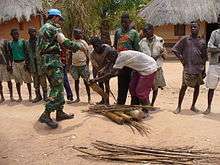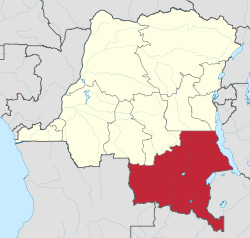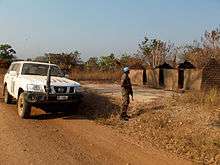Katanga insurgency
The Katanga insurgency refers to the ongoing rebellion by a number of rebel groups in the Democratic Republic of the Congo, some of which aim for the creation of a separate state within Katanga. While the insurgency has been active in various forms since 1960, insurgent groups have recently redoubled their efforts after the 2011 jail break that freed Gédéon Kyungu Mutanga, who now commands the majority of the Katangese separatist groups.
| Katanga Insurgency | ||||||||
|---|---|---|---|---|---|---|---|---|
 Mai Mai militants surrendering in northern Katanga. | ||||||||
| ||||||||
| Belligerents | ||||||||
| Self-defence groups[1] |
| CNPSC | ||||||
| Commanders and leaders | ||||||||
|
|
|
| ||||||
| Strength | ||||||||
| 1,000–3,000 | 6,000–7,000 in the entire DRC | |||||||
| Casualties and losses | ||||||||
| Unknown | 585–725 militants killed | Unknown | ||||||
| 600,000 internally displaced persons,[14] hundreds of thousands of excess deaths, hundreds of thousands of civilians killed | ||||||||
Since 2000, FDLR insurgents have been engaged in a low level military conflict with the FARDC and various Katangese separatist groups; the FDLR are mostly active in the north-eastern portion of Katanga province near the border with South Kivu. The conflict in the region has caused an exodus of around 600,000 refugees to various other parts of the DRC and an unknown number of civilians have died as a result of the conflict.
Background
Insurrection and political instability first appeared in Katanga immediately after Democratic Republic of the Congo's independence in 1960. The region attempted to create a breakaway state with the support of Belgium, which aimed to create a puppet state and gain access to the mineral rich region. The State of Katanga however failed to defend its independence during the Congo Crisis and was integrated into Congo in 1963.[5]
Between 1977 and 1978, Front for the National Liberation of the Congo sparked two major conflicts in the region known as Shaba I and Shaba II.[15] A number of separatist groups have conducted a low intensity insurgency since the end of Shaba II, the main factions being Co-ordination for a Referendum on Self-determination for Katanga (CORAK) and Mai Mai Kata Katanga.[5][16][17]
On 9 September 2011, rebel leader Gédéon Kyungu Mutanga managed to escape the Kassapa prison where he was detained. Mutanga soon established the Mai Mai Kata Katanga a rebel faction aiming to create an independent Katanga state.[17] Mutanga also established Mai Mai Gédéon effectively having two separate militia groups under his command. These two militias primarily operate in the Mitwaba, Manono and Pweto localities of Katanga Province; an area that has been nicknamed the "Triangle of Death' as a result of the conflict.[18]
Timeline

On 15 October 2004, rebels attacked the town of Kilwa, approximately 3,000 people fled into neighboring Zambia in the aftermath of the attack.[11]
On 20 October 2004, security forces recaptured Kilwa killing 30 insurgents and detaining rebel commander Alain Ilunga Mukalyi as well as several other rebels.[11]
On 23 May 2010, authorities apprehended 7 separatists belonging to CPK on charges of planning an attack on the Vangu military camp. Three AK- 47 rifles, Katangese flags as well as ritual fetishes were confiscated from the militants.[19]
On 23 November 2010, militants raided a village situated in the vicinity of Luena.[10]
On 26 November 2010, FARDC bombed rebel positions and engaged in clashes with insurgents in the area of Luena. A total of 6 people were killed including 1 government soldier and 5 insurgents, 12 insurgents were also captured. Among those killed was rebel leader Yesu Mulongo.[10]
On 11 January 2011, FARDC recaptured the towns of Bendera, Wimbi, Kabimba and Lunga, previously controlled by FDLR. A total of 19 insurgents and 3 government soldiers were killed during the fighting.[20]
On 5 February 2011, Katangese Separatists seized control of the Luano airport in Lubambashi but were forced out of the area by members of the FARDC and the local police. One death was reported and local sources indicated that the attack may have been done by the insurgent group known as the CPK.[2]
.jpg)
On the night of 11 July 2011, suspected CORAK militants attacked the Kimbembe military base, an unspecified number of people was killed in the incident. On July 1, CORAK issued a statement calling for the independence of Katanga.[21]
On 9 September 2011, a group of masked gunmen raided the Kassapa prison facility near Lubumbashi, killing two guards and freeing 967 prisoners. Among the prisoners that escaped was Gedeon Kyungu Mutanga a former Mai Mai commander as well as members of the Referendum on Self-Determination for Katanga (Corak) rebel faction. At least 230 escapees were recaptured within days after the jailbreak, while bounties ranging from $100,000 to $500 were placed on the rest.[17]
On 27 November 2011, a weapons depot located in the Major Nvangu à Lubumbashi military camp was destroyed in the aftermath of an arson attack, one of the soldiers guarding the depot was also killed in the incident. A military spokesman accused CORAK of carrying the attack.[22]
On 27 December 2011, trials of CORAK militants began at the Lubumbashi garrison military court, the defendants were accused of desertion and insurrection among other charges. The accused included militants arrested during the February 2011 Luano airport attack and the Kassapo prison brake. The next hearing was scheduled to be held on 6 January 2012.[23]
On 21 December 2012, two insurgents and one government soldier was killed when rebels clashed with security forces outside the Lubumbashi airport. Three militants were also captured.A few days before the incident Angola based insurgents threatened of upcoming attacks.[16]
On 23 March 2013, between 300 and 350 Kata Katanga militia launched unsuccessful an attack on Lubumbashi later fleeing into a United Nations compound surrendering, a total of 245 militants were detained. 35 people were killed and 60 wounded during the clashes.[24]
In August 2013, the UN mission in the Democratic Republic of the Congo, MONUSCO, rescued 82 children, some as young as eight, who had been forcibly recruited to the militia as child soldiers.[25] MONUSCO stated that a total of 163, including 22 girls, have been freed since the beginning of the year.[25] The UN Office for the Coordination of Humanitarian Affairs said in a March 8 report that the humanitarian effects have spread to half of Katanga's 22 territories.[26]
On 8 October 2013, rebel commander Albert “Yorgo” Kisimba surrendered to local authorities in Manomo. Three weeks earlier Kisimba's family along with 50 militants had also capitulated at the same location.[27]
According to DRC authorities hundreds of Mai Mai militants deserted the movement during 2013.[28]
It was reported that 35 attacks rebel attacks occurred within the first four months of 2014, the incidents occurred in the Katangese territories of Kalemie, Manono, Mitaba, Pweto, and Moba.[5]
On 7 January 2014, Bakata Katanga separatists launched an attack on Lubumbashi, the attack was repelled by security forces after a skirmish in Kiziba, southeast of Lubumbashi. A total of 26 people were killed during the clashes, as scores of civilians fled the city.[5]
On 5 April 2014, FDLR guerrillas pillaged a number of villages and ambushed cargo trucks on Route Nationale 5, near Kabulo in Kalemie territory.[5]
On 19 May 2014, Congolese authorities detained Kata Katanga commander Fidel Ntumbi in the town of Mpyana.[29]
On 6 July 2014, the Congolese army retook the town of Wimbi previously occupied by elements of Mai Mai Yakutumba, the militants looted the town, stealing fuel, livestock and other material goods.[30]
On 7 August 2014, FDLR rebels ambushed a bus outside the village of Kanyangwe, killing one and seriously injuring two people.[31]
On 12 September 2014, a group of 10 militants shot dead a police officer along with his wife in the town of Malemba Nkulu, the rebels then proceeded to plunder the town, later torching 10 houses and taking 3 people hostage.[32]
On 16 September 2014, the Congolese military announced the take over of 11 towns previously controlled by Bakata Katanga rebels including: Ndela, Kabunda, Kishale, Paza, Nkokole, Muluvia, Kabala, Lubinda, Lenge Wa Bangi, Lenge Wa Bunga, and Kyungu. Mai Mai Gédéon commander Kafilo was recognised among those killed during clashes that took place earlier in September.[33]
On 26 September 2014, MONUSCO confirmed the death of Bakata Katanga commander Kasompobe, whose corpse was discovered on the shore of the Luvua river on September 12.[33]
On 27 September 2014, 6 Bakata Katanga militants were killed during fighting in the vicinity of Kingoma. In a separate event 2 Maï-Maï Yakutumba insurgents were detained in the village of Manyanga. Several days earlier FARDC killed and injured a number of Bakata Katanga separatists in the village of Kapanda, two rifles and a large number of arrows were captured during the operation.[4]
Between 5–6 October 2014, Mai-Mai militants burned 60 houses in Katuba, Kasamba Kilangwa and Kanswa, forcing 3,000 civilians to flee into Dikulushi. At the same time FARDC raided the central Mai Mai Gédéon headquarters located at Moba, freeing 13 hostages.[34][35]
On 2 November 2014, Mai Mai Gédéon separatists launched simultaneous attacks on three villages in the region of Upemba.[36]
On 4 November 2014, Bakata Katanga fighters ambushed two vehicles belonging to the Upemba national park rangers, taking four people hostage and seizing four rifles. At the same time an launching an unsuccessful attack on a FARDC outpost in the village of Muvule.[37]

On 7 November 2014, government troops captured the Mai Mai Gédéon headquarters located in Musumari forcing the separatists to withdraw from the area after suffering heavy casualties. Four rifles and big stacks of arrows were also confiscated.[36]
On 6 January 2015, FARDC arrested Jacques Mukashama (also known as Bwananyama). Mukashama lead FDLR elements in the Northern part of Katanga province.[38]
On 31 January 2015, FARDC commander in Katanga Jean Claude Kifwa announced that a total of 18 Bakata Katanga fighters defected from the movement in the last quarter of 2014 following a successful propaganda campaign in the Pweto-Mitwaba-Manono triangle.[39]
On 17 March 2015, Congolese authorities released a report regarding the Katanga insurgency, the report indicated a fall in Mai Mai activity. Kalenge, Bakwanga, Oto and Madrakua, are considered to be the last Mai Mai commanders in the region, the detention of Oto's wife was also announced.[40]
Mai-Mai Kata Katanga made several incursions into Lubumbashi in 2019. Three government soldiers and two rebels were killed during a confrontation in the city in October 2019.[41]
See also
- Mai Mai
- Congo Crisis
References
- United Nations Security Council. "Security Council Report" (PDF). UNSC. Archived (PDF) from the original on 24 September 2015. Retrieved 20 January 2015.
- "The Global Intelligence Files". Archived from the original on 5 January 2015. Retrieved 9 January 2015.
- "BBC News - Katanga: Fighting for DR Congo's cash cow to secede". BBC News. Archived from the original on 8 January 2015. Retrieved 2 January 2015.
- "Pweto/Katanga : Les Bakata Katanga sont loin à désarmer". L' Observateur. 15 October 2014. Archived from the original on 7 December 2014. Retrieved 22 January 2015.
- "Increasing Mai-Mai attacks in Katanga raise security risks to DRC mining operations and road cargo". Janes. 5 May 2014. Archived from the original on December 9, 2014. Retrieved 8 December 2014.
- "Congo: Kabila reshuffles his military pack – By Alex Ntung - African Arguments". Archived from the original on 9 January 2015. Retrieved 9 January 2015.
- Congo Militia Attacks Police Chief's House in Katanga Archived 2017-10-13 at the Wayback Machine Bloomberg. Published October 29, 2013. Retrieved April 2, 2015.
- Trésor Kibangula (14 May 2013). "- Le Katanga, au-delà des mines - Katanga : qui se cache derrière les Kata Katanga ? - Jeuneafrique.com - le premier site d'information et d'actualité sur l'Afrique". JEUNEAFRIQUE.COM. Archived from the original on 9 January 2015. Retrieved 9 January 2015.
- Chris McGreal. "US tells armed group in DRC to surrender or face 'military option'". the Guardian. Archived from the original on 10 July 2017. Retrieved 2 January 2015.
- "Calm returns to DR Congo's Katanga province after insurgency". Xinhua. 1 December 2010. Archived from the original on 5 February 2016. Retrieved 8 December 2014.
- captured "DRC: Leader of Katanga insurgents captured" Check
|url=value (help). Irin News. 20 October 2004. Archived from the original on 9 December 2014. Retrieved 8 December 2014. - Bariyo, Nicholas (26 February 2014). "U.N. Bolsters Congo Mission". WSJ. Archived from the original on 12 July 2015. Retrieved 8 December 2014.
- "UN Sends More Troops to DR Congo's Troubled Katanga Region." Archived 2016-08-23 at the Wayback Machine Modern Ghana. Accessed August 07, 2016.
- United Nations High Commissioner for Refugees. "UNHCR - UNHCR is alarmed about ignored humanitarian catastrophe in DRC's Katanga province". UNHCR. Archived from the original on 31 December 2014. Retrieved 2 January 2015.
- Ministère de la Défense. ""OPÉRATION LÉOPARD" Une intervention humanitaire Kolwezi 17 mai-16 juin 1978" (PDF). Collection « Mémoire et Citoyenneté » n° 37. Defense.gouv.fr. p. 8. Archived (PDF) from the original on 2014-04-08. Retrieved 1 April 2014.
- "Three die in attack near DRC airport". SAPA. 21 December 2012. Archived from the original on 2 April 2015. Retrieved 11 December 2014.
- "more details on Katanga prison bust out". Wikileaks. 9 September 2011. Archived from the original on 27 September 2015. Retrieved 10 December 2014.
- "Militia Group Razes Down Over 60 Villages In DR Congo's Katanga Province - Nigerian News from Leadership Newspapers". Nigerian News from Leadership Newspapers. Archived from the original on 5 January 2015. Retrieved 9 January 2015.
- "Troubles de Lubumbashi: 7 suspects arrêtés". Radio Okapi. 23 May 2010. Archived from the original on 1 July 2014. Retrieved 22 January 2015.
- "Katanga: traque contre les FDLR, 19 rebelles et 3 militaires des FARDC tués". Radio Okapi. 11 January 2011. Archived from the original on 23 January 2015. Retrieved 22 January 2015.
- {{cite web|url=http://radiookapi.net/actualite/2011/07/11/attaque-contre-un-camp-militaire-a-lubumbashi/|title=Attaque contre un camp militaire à Lubumbashi|work=Radio Okapi|date=11 July 2011|accessdate=22 January 2015}}
- "Lubumbashi : attaque d'un dépôt d'armes du camp Major Nvangu". Radio Okapi. 27 November 2011. Archived from the original on 30 March 2015. Retrieved 22 January 2015.
- "Début du procès des rebelles indépendantistes du Katanga". Radio Okapi. 27 December 2011. Archived from the original on 12 September 2014. Retrieved 22 January 2015.
- Kavanagh, Michael (24 March 2013). "Congo Rebel Attack in Katanga Province Leaves 35 Dead, UN Says". Bloomberg. Archived from the original on 5 January 2014. Retrieved 20 January 2015.
- "DR Congo unrest: Children freed from militia, says UN". bbcnews.com. 16 August 2013. Archived from the original on 27 August 2013. Retrieved 21 September 2013.
- Kavanagh, Michael (24 March 2013). "Congo Rebel Attack in Katanga Province Leaves 35 Dead, UNSays". bloomberg.com. Archived from the original on 23 September 2013. Retrieved 15 September 2013.
- "Katanga: le chef milicien "Yorgo" se rend aux FARDC". Radio Okapi. 8 October 2013. Archived from the original on 4 March 2016. Retrieved 22 January 2015.
- "Katanga: Fighting for DR Congo's cash cow to secede". BBC. 11 August 2013. Archived from the original on 10 December 2014. Retrieved 8 December 2014.
- "Transfèrement à Lubumbashi, du Chef Mai Mai Kata Katanga Fidel Ntumbi de Manono". Star Africa. 27 May 2014. Archived from the original on 21 January 2015. Retrieved 20 January 2015.
- "Katanga: l'armée reprend le contrôle de Wimbi 9". Radio Okapi. 8 July 2014. Archived from the original on 23 January 2015. Retrieved 22 January 2015.
- "Katanga: des présumés rebelles FDLR tuent une personne dans l'attaque d'un minibus". Radio Okapi. 8 August 2014. Archived from the original on 7 September 2014. Retrieved 22 January 2015.
- "Katanga : 2 morts dans une attaque des Maï-Maï à Malemba Nkulu". Radio Okapi. 14 September 2014. Archived from the original on 29 March 2015. Retrieved 22 January 2015.
- "Manono/Katanga : Le chef rebelle Maï Maï Bakata Katanga Kasompobe retrouvé mort". L' Observateur. 26 September 2014. Archived from the original on 8 December 2014. Retrieved 22 January 2015.
- "Katanga: 3 000 personnes fuient Kyona Nzini après une incursion des Maï-Maï". Radio Okapi. 12 October 2014. Archived from the original on 21 January 2015. Retrieved 20 January 2015.
- "RD Congo : L ' armée chasse le seigneur de guerre Gédéon de sa base de Moba au Katanga". Star Africa. 12 October 2014. Archived from the original on 30 November 2014. Retrieved 20 January 2015.
- "RDC: offensive de l'armée contre les Maï Maï Kata Katanga – RFI". Radio Okapi. 7 November 2014. Archived from the original on January 16, 2015. Retrieved 22 January 2015.
- "Deux attaques des miliciens Bakata Katanga enregistrées à Mitwaba". Radio Okapi. 4 November 2014. Archived from the original on 4 December 2014. Retrieved 22 January 2015.
- "Katanga : arrestation d'un présumé collaborateur des FDLR à Kalusu". Radio Okapi. 6 January 2015. Archived from the original on 21 January 2015. Retrieved 20 January 2015.
- "Katanga: 18 Maï-Maï Bakata Katanga se rendent aux FARDC". Radio Okapi. 31 January 2015. Archived from the original on 2 February 2015. Retrieved 31 January 2015.
- "Katanga: baisse de l'activisme de Maï-Maï à Manono, Pweto et Moba". Radio Okapi. 17 May 2015. Archived from the original on 19 April 2015. Retrieved 24 May 2015.
- "RDC: trois soldats tués dans des affrontements avec une milice à Lubumbashi". La Libre Belgique (Afrique). 11 October 2019. Retrieved 4 November 2019.